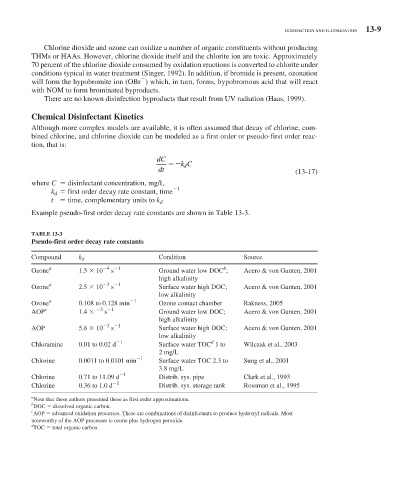Page 514 - Water and wastewater engineering
P. 514
DISINFECTION AND FLUORIDATION 13-9
Chlorine dioxide and ozone can oxidize a number of organic constituents without producing
THMs or HAAs. However, chlorine dioxide itself and the chlorite ion are toxic. Approximately
70 percent of the chlorine dioxide consumed by oxidation reactions is converted to chlorite under
conditions typical in water treatment (Singer, 1992). In addition, if bromide is present, ozonation
will form the hypobromite ion (OBr ) which, in turn, forms, hypobromous acid that will react
with NOM to form brominated byproducts.
There are no known disinfection byproducts that result from UV radiation (Haas, 1999).
Chemical Disinfectant Kinetics
Although more complex models are available, it is often assumed that decay of chlorine, com-
bined chlorine, and chlorine dioxide can be modeled as a first order or pseudo-first order reac-
tion, that is:
dC
kC
d
dt (13-17)
where C disinfectant concentration, mg/L
1
k d first order decay rate constant, time
t time, complementary units to k d
Example pseudo-first order decay rate constants are shown in Table 13-3 .
TABLE 13-3
Pseudo-first order decay rate constants
Compound k d Condition Source
b
4 1
Ozone a 1.5 10 s Ground water low DOC ; Acero & von Gunten, 2001
high alkalinity
3 1
Ozone a 2.5 10 s Surface water high DOC; Acero & von Gunten, 2001
low alkalinity
Ozone a 0.108 to 0.128 min 1 Ozone contact chamber Rakness, 2005
3 1
AOP c 1.4 s Ground water low DOC; Acero & von Gunten, 2001
high alkalinity
s
AOP 5.8 10 3 1 Surface water high DOC; Acero & von Gunten, 2001
low alkalinity
d
Chloramine 0.01 to 0.02 d 1 Surface water TOC 1 to Wilczak et al., 2003
2 mg/L
Chlorine 0.0011 to 0.0101 min 1 Surface water TOC 2.3 to Sung et al., 2001
3.8 mg/L
Chlorine 0.71 to 11.09 d 1 Distrib. sys. pipe Clark et al., 1993
Chlorine 0.36 to 1.0 d 1 Distrib. sys. storage tank Rossman et al., 1995
a
Note that these authors presented these as first order approximations.
b
DOC dissolved organic carbon.
c
AOP advanced oxidation processes. These are combinations of disinfectants to produce hydroxyl radicals. Most
noteworthy of the AOP processes is ozone plus hydrogen peroxide.
d
TOC total organic carbon.

